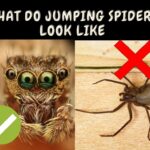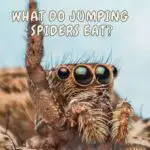Regarded as one of the largest jumping spiders in Australia, Mopsus Mormon jumping spider is no doubt one of the most fascinating jumping spider species we have encountered. While our furry friend is the sole species of the genus Mopsus, it is an integral member of the family Salticidae.
Despite our leaper friends’ widespread distribution, they are predominantly found in eastern Australia and New Guinea. And because of their dominant green color, Mopsus Mormon is commonly called the green jumping spider.
Like most jumping spiders we have come across, Mopsus Mormon has a lot going on in terms of their appearance, hunting behavior, what they like to eat, and a host of other unique antics that are common among members of this genus.
Stay with us for the big reveal, as today’s post will help you learn more about this intelligent species of jumping spider.
What is their scientific name?
If you’re new to jumping spiders, then we are happy to tell you that most jumping spiders have a general name they are called. But besides their general name, most jumping spiders also have a scientific name they go by.
As per their general name, our fuzzy friends go by many common names, including Green jumping spider, Northern Green jumping spider, and Clown spider. On the flip side, the Green jumping spider is scientifically called Mopsus Mormon, a name that followed it since it was first described.
However, while their name is of much significance, many spider enthusiasts have come to love Green jumping spiders because of their unique behavior, overwhelming physical features, and sheer intelligence. Stay tight while we introduce you to the world of Green jumping spiders as far as their physical features and size are concerned.
Physical features and size
The green jumping spider is regarded as one of Australia’s larger jumping spiders. At 12 mm, this jumping spider is one of the biggest jumping spiders we have encountered in this region. While females come in slightly longer than their male counterparts, the difference in their size isn’t that significant.
With so many things going on in terms of their physical characteristics, we will take a moment to give you some vivid description of the Green jumping spider.. While females of this jumping spider are somewhat variable, their predominantly leafy green color makes them easy to identify.
Despite their predominantly green-colored bodies, green jumping spiders also spot distinct white patches around their eyes. This is closely followed by two black lines that travel along their dorsal abdomen.
Although adult males of this jumping spider species look somewhat similar to their female counterparts, they feature a prominent fringe of white hairs on either side of their eye patterns.
Also, while their front pair of large eyes cover over half of their dark face, you’ll find some rather huge fangs just below their eyes. And just so you know, Morpsus Mormon have legs that appear green to dark red.
During close observations, adult males of this jumping spider species were observed to have colorful and decorated long white side-whiskers. These side whiskers rise almost to a peak surmounted by a loose collection of black hairs. And even though the females of this jumping spider species are missing the white whiskers and top knots common among males of this jumping spider species, they feature some kind of red and white mask.
Where are they from?
Even though the Green jumping spider can thrive very well in any environment it is introduced to; this jumping spider species is predominantly found in Australia and New Guinea.
Over the last couple of years, some specimen of this jumping spider has been collected from various areas in Australia. While some of these jumping spiders have been spotted in Northern Australia and the south-east of Queensland, a host of them have been found in New Guinea.
The Green jumping spider is stretching its base to Brisbane, and experts believe that it is only a matter of time before they expand their range southwards.
When it comes to their preferred habitat, the green jumping spider likes to hang around areas with abundant leaves and shrubs. Also, they may sometimes storm human settlements in search of food.
Diet/food
Green jumping spiders have been described as daylight hunters with multi-purpose vision, and that’s because our furry friends are most active during the day. Thanks to their excellent eyesight, Green jumping spiders can hunt and recognize prey from some distance away.
While they mainly feast on small insects like mosquitoes, flies, aphids, crickets, ants, and butterflies, their large size means they can take on prey twice their size.
Although most traditional jumping spiders use their webs for hunting, Green jumping spiders favor their incredible jumping skills when hunting. And because they can leap almost 20 times their body length, it’s super easy for Green jumping spiders to pounce on their prey when they spot one.
What is their temperament?
Like most jumping spider species we have encountered, the green jumping spider is calm, collected, and friendly. Yes, they might sometimes act aggressive and vicious towards prey, but their first instinct is to get away when they spot humans. Thanks to their friendly nature, many exotic pet lovers will enjoy keeping them as pets.
Is it dangerous or venomous to humans?
Although Green jumping spiders are believed to have painful bites, they only bite when they feel threatened. While they are venomous, their venom doesn’t harm humans.
Frequently asked questions: Learn more about Green jumping spider.
Are they aggressive?
Just like other jumping spider species, Morpsus Mormon acts aggressively and viciously towards their prey. That said, around humans, they are super calm, collected, and friendly.
Can you raise them as pets?
If you’re looking for an exotic pet to add to your collection, you’ll not be disappointed to give green jumping spiders a try, and that’s because they are friendly and don’t pose any threat to humans.
What do they eat?
Green jumping spiders eat a variety of small and large insects, including flies, mosquitoes, butterflies, aphids, crickets, ants, and other tiny spiders.



